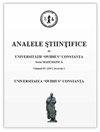偶极体III型热弹性的定性结果
IF 0.8
4区 数学
Q2 MATHEMATICS
Analele Stiintifice Ale Universitatii Ovidius Constanta-Seria Matematica
Pub Date : 2021-03-01
DOI:10.2478/auom-2021-0009
引用次数: 0
摘要
在我们的研究中,我们建立了与偶极结构体的III型热弹性相对应的混合初边值问题。在主要部分,我们接近四个定性结果关于解决这个问题。在其中的两个定理(前两个定理)中,我们得到了两个唯一性的结果,用不同的方法证明。此外,我们还证明了两个结果,证明了所考虑问题的解对供给项是连续依赖的。对于连续相关的两个定理,我们使用了不同的处理方法,但我们本质上依赖于第3节和gronwall型不等式的辅助结果。必须强调的是,所有的结果都是通过对连续固体力学中常见的基本方程和基本条件施加平均约束而得到的。本文章由计算机程序翻译,如有差异,请以英文原文为准。
Qualitative results in thermoelasticity of type III for dipolar bodies
Abstract In our study we formulated the mixed initial boundary value problem corresponding to the thermoelasticity of type III for bodies with dipolar structure. In main section we approached four qualitative results regarding the solutions for this problem. In two of these (in the first two theorems) we obtained two results of uniqueness, proved in different ways. Also, we proven two results which show that the solutions of the considered problem depend continuously with respect to the supply terms. We use different procedures in the two theorems on continuous dependence, but we essentially rely on the auxiliary results from Section 3 and Gronwall-type inequalities. It is important to emphasize that all results are obtained by imposing on the basic equations and basic conditions, average constraints that are common in the mechanics of continuous solids.
求助全文
通过发布文献求助,成功后即可免费获取论文全文。
去求助
来源期刊

Analele Stiintifice Ale Universitatii Ovidius Constanta-Seria Matematica
MATHEMATICS, APPLIED-MATHEMATICS
CiteScore
1.30
自引率
0.00%
发文量
15
审稿时长
6-12 weeks
期刊介绍:
This journal is founded by Mirela Stefanescu and Silviu Sburlan in 1993 and is devoted to pure and applied mathematics. Published by Faculty of Mathematics and Computer Science, Ovidius University, Constanta, Romania.
 求助内容:
求助内容: 应助结果提醒方式:
应助结果提醒方式:


